Advanced Financial Accounting Report: Asset Revaluation Analysis
VerifiedAdded on 2021/06/17
|12
|2799
|265
Report
AI Summary
This report provides a comprehensive analysis of advanced financial accounting principles. It examines the qualitative characteristics of financial reporting under IFRS, incorporating opinions from financial experts on understandability, relevance, and verifiability. The report then delves into regulatory theories, including Public Interest Theory, Capture Theory, and Economic Interest Group Theory, to explain the Australian government's approach to environmental and social responsibilities. Furthermore, it discusses the implications of FASB Statement No. 144 on asset valuation in the US, highlighting its impact on the relevance and representational faithfulness of financial statements. Finally, the report explores the motivations behind asset revaluation and the effects of non-revaluation on financial statements, offering insights into asset values, fair value determination, and financial strategy development.

Running head: ADVANCED FINANCIAL ACCOUNTING
Advanced Financial Accounting
Name of the Student
Name of the University
Author’s Note
Advanced Financial Accounting
Name of the Student
Name of the University
Author’s Note
Paraphrase This Document
Need a fresh take? Get an instant paraphrase of this document with our AI Paraphraser
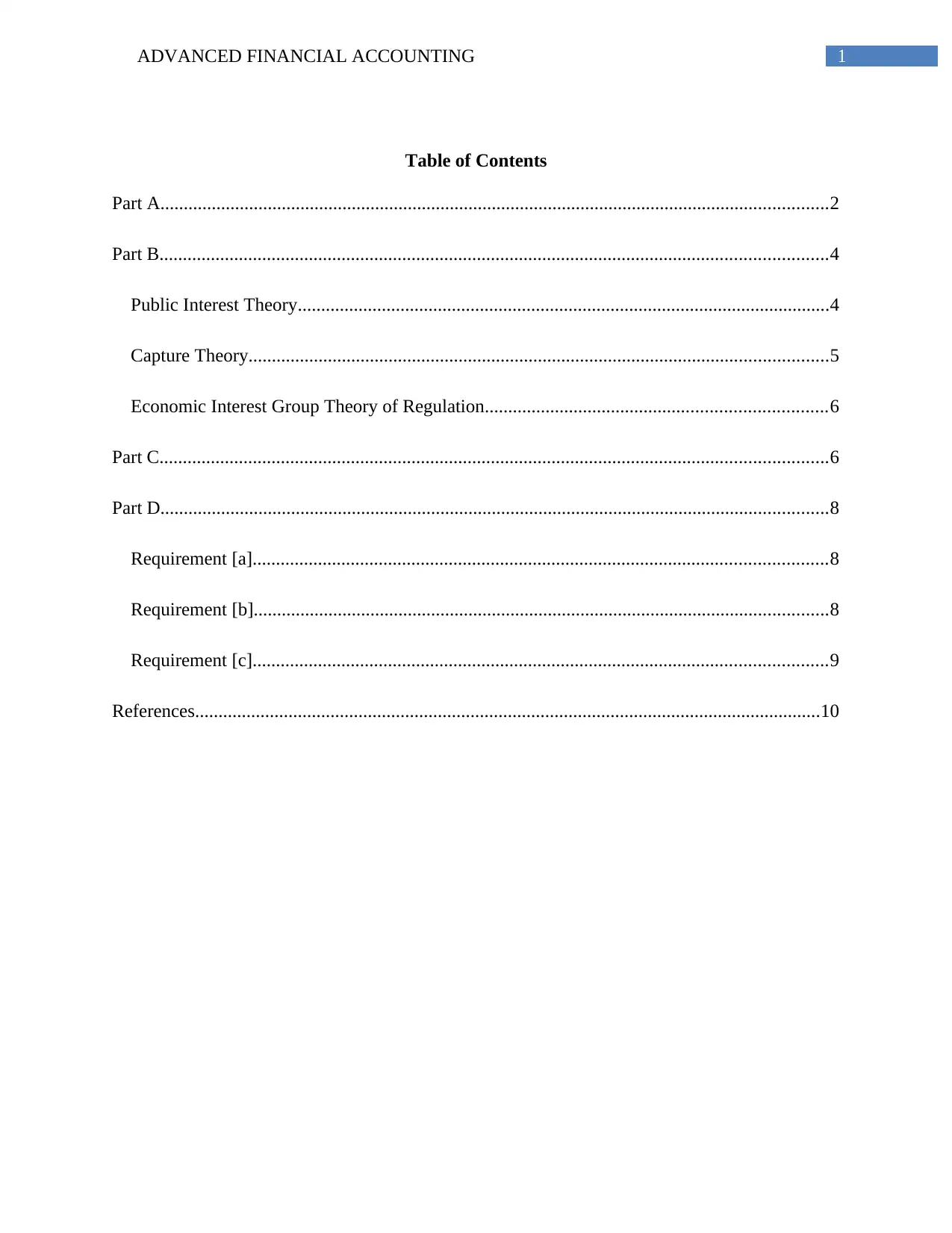
1ADVANCED FINANCIAL ACCOUNTING
Table of Contents
Part A...............................................................................................................................................2
Part B...............................................................................................................................................4
Public Interest Theory..................................................................................................................4
Capture Theory............................................................................................................................5
Economic Interest Group Theory of Regulation.........................................................................6
Part C...............................................................................................................................................6
Part D...............................................................................................................................................8
Requirement [a]...........................................................................................................................8
Requirement [b]...........................................................................................................................8
Requirement [c]...........................................................................................................................9
References......................................................................................................................................10
Table of Contents
Part A...............................................................................................................................................2
Part B...............................................................................................................................................4
Public Interest Theory..................................................................................................................4
Capture Theory............................................................................................................................5
Economic Interest Group Theory of Regulation.........................................................................6
Part C...............................................................................................................................................6
Part D...............................................................................................................................................8
Requirement [a]...........................................................................................................................8
Requirement [b]...........................................................................................................................8
Requirement [c]...........................................................................................................................9
References......................................................................................................................................10
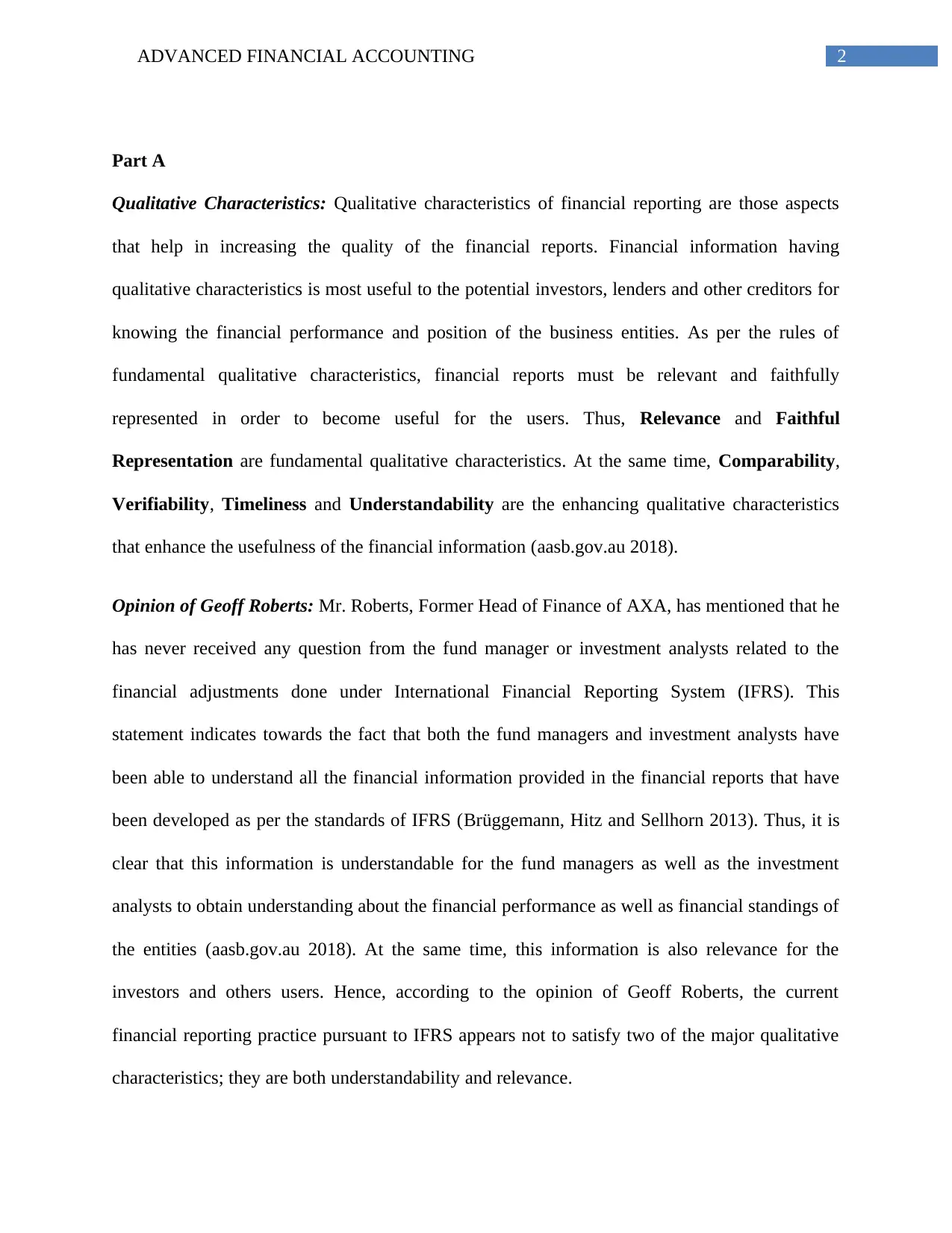
2ADVANCED FINANCIAL ACCOUNTING
Part A
Qualitative Characteristics: Qualitative characteristics of financial reporting are those aspects
that help in increasing the quality of the financial reports. Financial information having
qualitative characteristics is most useful to the potential investors, lenders and other creditors for
knowing the financial performance and position of the business entities. As per the rules of
fundamental qualitative characteristics, financial reports must be relevant and faithfully
represented in order to become useful for the users. Thus, Relevance and Faithful
Representation are fundamental qualitative characteristics. At the same time, Comparability,
Verifiability, Timeliness and Understandability are the enhancing qualitative characteristics
that enhance the usefulness of the financial information (aasb.gov.au 2018).
Opinion of Geoff Roberts: Mr. Roberts, Former Head of Finance of AXA, has mentioned that he
has never received any question from the fund manager or investment analysts related to the
financial adjustments done under International Financial Reporting System (IFRS). This
statement indicates towards the fact that both the fund managers and investment analysts have
been able to understand all the financial information provided in the financial reports that have
been developed as per the standards of IFRS (Brüggemann, Hitz and Sellhorn 2013). Thus, it is
clear that this information is understandable for the fund managers as well as the investment
analysts to obtain understanding about the financial performance as well as financial standings of
the entities (aasb.gov.au 2018). At the same time, this information is also relevance for the
investors and others users. Hence, according to the opinion of Geoff Roberts, the current
financial reporting practice pursuant to IFRS appears not to satisfy two of the major qualitative
characteristics; they are both understandability and relevance.
Part A
Qualitative Characteristics: Qualitative characteristics of financial reporting are those aspects
that help in increasing the quality of the financial reports. Financial information having
qualitative characteristics is most useful to the potential investors, lenders and other creditors for
knowing the financial performance and position of the business entities. As per the rules of
fundamental qualitative characteristics, financial reports must be relevant and faithfully
represented in order to become useful for the users. Thus, Relevance and Faithful
Representation are fundamental qualitative characteristics. At the same time, Comparability,
Verifiability, Timeliness and Understandability are the enhancing qualitative characteristics
that enhance the usefulness of the financial information (aasb.gov.au 2018).
Opinion of Geoff Roberts: Mr. Roberts, Former Head of Finance of AXA, has mentioned that he
has never received any question from the fund manager or investment analysts related to the
financial adjustments done under International Financial Reporting System (IFRS). This
statement indicates towards the fact that both the fund managers and investment analysts have
been able to understand all the financial information provided in the financial reports that have
been developed as per the standards of IFRS (Brüggemann, Hitz and Sellhorn 2013). Thus, it is
clear that this information is understandable for the fund managers as well as the investment
analysts to obtain understanding about the financial performance as well as financial standings of
the entities (aasb.gov.au 2018). At the same time, this information is also relevance for the
investors and others users. Hence, according to the opinion of Geoff Roberts, the current
financial reporting practice pursuant to IFRS appears not to satisfy two of the major qualitative
characteristics; they are both understandability and relevance.
⊘ This is a preview!⊘
Do you want full access?
Subscribe today to unlock all pages.

Trusted by 1+ million students worldwide

3ADVANCED FINANCIAL ACCOUNTING
Opinion of Terry Brown: The opinion of Terry Brown, Finance Director of Wesfarmers,
indicates towards another deficiency of IFRS adopted financial reports. As per him, the result of
the investigation of the IFRS accounts by the financial analysts would be the misinterpretation of
those accounts in the absence of effective technical knowledge in accounting and finance
(Horton, Serafeim and Serafeim 2013). This situation requires to be mentioned about verifiability
qualitative characteristic. In the presence of verifiability, different knowledgeable and
independent observers can reach to a common agreement about the financial performance and
position of the business entities when analyzing the financial statements (aasb.gov.au 2018).
However, exception of this fact can be seen in the opinion of Terry Brown. According to him,
financial analysts and other users can be misled while interpreting the financial statements
developed as per the regulations of IFRS. Hence, this whole aspect indicates that the current
reporting practice pursuant to IFRS does not satisfy the verifiability qualitative characteristic of
financial reporting.
Opinion of David Craig: The opinion of David Craig, Chief Financial Officer of Commonwealth
Bank, point out towards another major deficiency of the financial statements developed as per
IFRS. He has mentioned in his statement that investors are now disregarding the financial
information as per IFRS due to the fact that they are obscuring the financial position of the
entities (Horton, Serafeim and Serafeim 2013). This aspect attracts the attention towards the
fundamental qualitative characteristics; they are relevance and faithful representation. Relevant
financial information is capable in making positive difference in the investment decisions of the
investors by providing information about the true financial position of the entities; at the same
time, faithful representation ensures that the financial information of the companies is faithfully
represented (aasb.gov.au 2018). Users will not be able to judge the true financial position of the
Opinion of Terry Brown: The opinion of Terry Brown, Finance Director of Wesfarmers,
indicates towards another deficiency of IFRS adopted financial reports. As per him, the result of
the investigation of the IFRS accounts by the financial analysts would be the misinterpretation of
those accounts in the absence of effective technical knowledge in accounting and finance
(Horton, Serafeim and Serafeim 2013). This situation requires to be mentioned about verifiability
qualitative characteristic. In the presence of verifiability, different knowledgeable and
independent observers can reach to a common agreement about the financial performance and
position of the business entities when analyzing the financial statements (aasb.gov.au 2018).
However, exception of this fact can be seen in the opinion of Terry Brown. According to him,
financial analysts and other users can be misled while interpreting the financial statements
developed as per the regulations of IFRS. Hence, this whole aspect indicates that the current
reporting practice pursuant to IFRS does not satisfy the verifiability qualitative characteristic of
financial reporting.
Opinion of David Craig: The opinion of David Craig, Chief Financial Officer of Commonwealth
Bank, point out towards another major deficiency of the financial statements developed as per
IFRS. He has mentioned in his statement that investors are now disregarding the financial
information as per IFRS due to the fact that they are obscuring the financial position of the
entities (Horton, Serafeim and Serafeim 2013). This aspect attracts the attention towards the
fundamental qualitative characteristics; they are relevance and faithful representation. Relevant
financial information is capable in making positive difference in the investment decisions of the
investors by providing information about the true financial position of the entities; at the same
time, faithful representation ensures that the financial information of the companies is faithfully
represented (aasb.gov.au 2018). Users will not be able to judge the true financial position of the
Paraphrase This Document
Need a fresh take? Get an instant paraphrase of this document with our AI Paraphraser
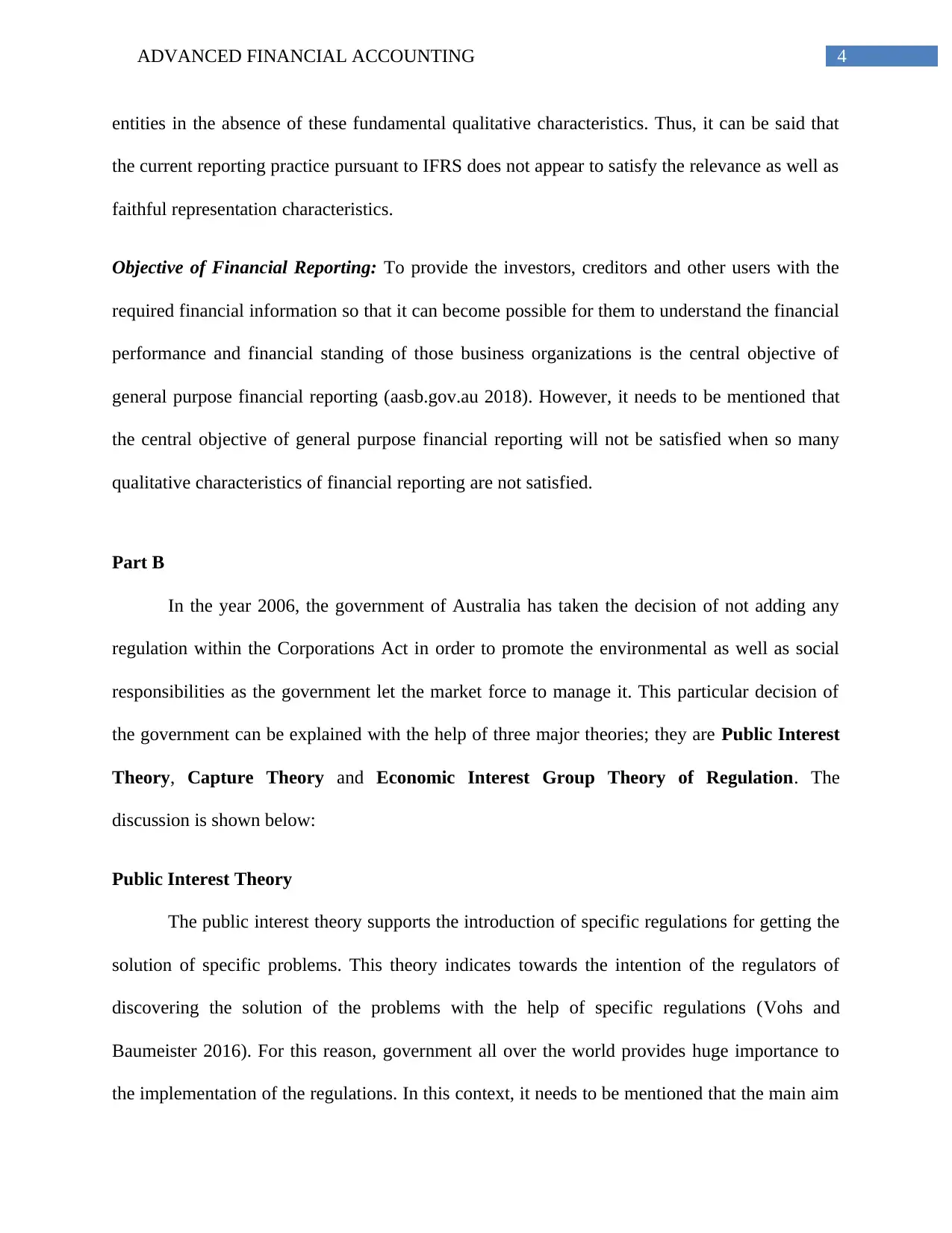
4ADVANCED FINANCIAL ACCOUNTING
entities in the absence of these fundamental qualitative characteristics. Thus, it can be said that
the current reporting practice pursuant to IFRS does not appear to satisfy the relevance as well as
faithful representation characteristics.
Objective of Financial Reporting: To provide the investors, creditors and other users with the
required financial information so that it can become possible for them to understand the financial
performance and financial standing of those business organizations is the central objective of
general purpose financial reporting (aasb.gov.au 2018). However, it needs to be mentioned that
the central objective of general purpose financial reporting will not be satisfied when so many
qualitative characteristics of financial reporting are not satisfied.
Part B
In the year 2006, the government of Australia has taken the decision of not adding any
regulation within the Corporations Act in order to promote the environmental as well as social
responsibilities as the government let the market force to manage it. This particular decision of
the government can be explained with the help of three major theories; they are Public Interest
Theory, Capture Theory and Economic Interest Group Theory of Regulation. The
discussion is shown below:
Public Interest Theory
The public interest theory supports the introduction of specific regulations for getting the
solution of specific problems. This theory indicates towards the intention of the regulators of
discovering the solution of the problems with the help of specific regulations (Vohs and
Baumeister 2016). For this reason, government all over the world provides huge importance to
the implementation of the regulations. In this context, it needs to be mentioned that the main aim
entities in the absence of these fundamental qualitative characteristics. Thus, it can be said that
the current reporting practice pursuant to IFRS does not appear to satisfy the relevance as well as
faithful representation characteristics.
Objective of Financial Reporting: To provide the investors, creditors and other users with the
required financial information so that it can become possible for them to understand the financial
performance and financial standing of those business organizations is the central objective of
general purpose financial reporting (aasb.gov.au 2018). However, it needs to be mentioned that
the central objective of general purpose financial reporting will not be satisfied when so many
qualitative characteristics of financial reporting are not satisfied.
Part B
In the year 2006, the government of Australia has taken the decision of not adding any
regulation within the Corporations Act in order to promote the environmental as well as social
responsibilities as the government let the market force to manage it. This particular decision of
the government can be explained with the help of three major theories; they are Public Interest
Theory, Capture Theory and Economic Interest Group Theory of Regulation. The
discussion is shown below:
Public Interest Theory
The public interest theory supports the introduction of specific regulations for getting the
solution of specific problems. This theory indicates towards the intention of the regulators of
discovering the solution of the problems with the help of specific regulations (Vohs and
Baumeister 2016). For this reason, government all over the world provides huge importance to
the implementation of the regulations. In this context, it needs to be mentioned that the main aim
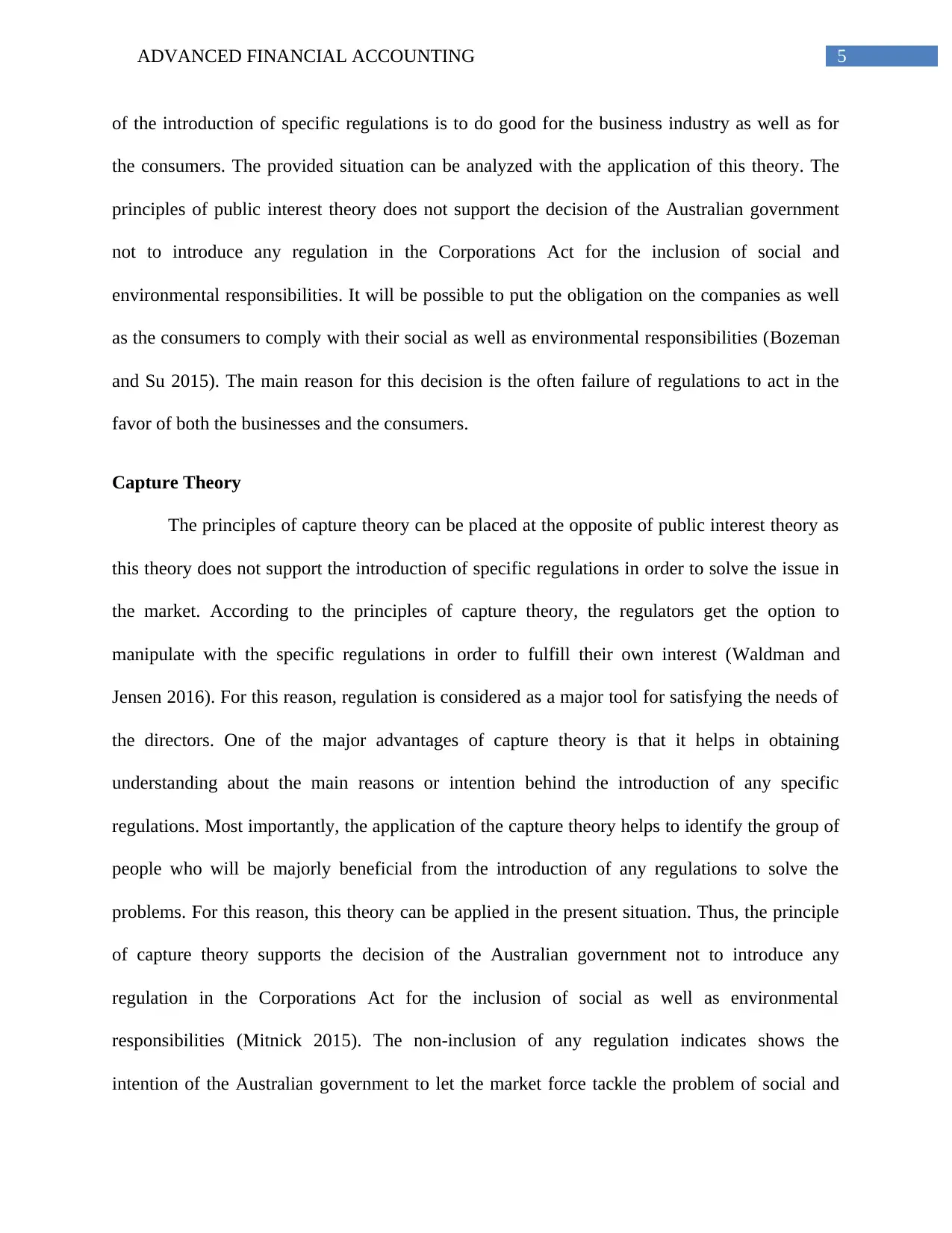
5ADVANCED FINANCIAL ACCOUNTING
of the introduction of specific regulations is to do good for the business industry as well as for
the consumers. The provided situation can be analyzed with the application of this theory. The
principles of public interest theory does not support the decision of the Australian government
not to introduce any regulation in the Corporations Act for the inclusion of social and
environmental responsibilities. It will be possible to put the obligation on the companies as well
as the consumers to comply with their social as well as environmental responsibilities (Bozeman
and Su 2015). The main reason for this decision is the often failure of regulations to act in the
favor of both the businesses and the consumers.
Capture Theory
The principles of capture theory can be placed at the opposite of public interest theory as
this theory does not support the introduction of specific regulations in order to solve the issue in
the market. According to the principles of capture theory, the regulators get the option to
manipulate with the specific regulations in order to fulfill their own interest (Waldman and
Jensen 2016). For this reason, regulation is considered as a major tool for satisfying the needs of
the directors. One of the major advantages of capture theory is that it helps in obtaining
understanding about the main reasons or intention behind the introduction of any specific
regulations. Most importantly, the application of the capture theory helps to identify the group of
people who will be majorly beneficial from the introduction of any regulations to solve the
problems. For this reason, this theory can be applied in the present situation. Thus, the principle
of capture theory supports the decision of the Australian government not to introduce any
regulation in the Corporations Act for the inclusion of social as well as environmental
responsibilities (Mitnick 2015). The non-inclusion of any regulation indicates shows the
intention of the Australian government to let the market force tackle the problem of social and
of the introduction of specific regulations is to do good for the business industry as well as for
the consumers. The provided situation can be analyzed with the application of this theory. The
principles of public interest theory does not support the decision of the Australian government
not to introduce any regulation in the Corporations Act for the inclusion of social and
environmental responsibilities. It will be possible to put the obligation on the companies as well
as the consumers to comply with their social as well as environmental responsibilities (Bozeman
and Su 2015). The main reason for this decision is the often failure of regulations to act in the
favor of both the businesses and the consumers.
Capture Theory
The principles of capture theory can be placed at the opposite of public interest theory as
this theory does not support the introduction of specific regulations in order to solve the issue in
the market. According to the principles of capture theory, the regulators get the option to
manipulate with the specific regulations in order to fulfill their own interest (Waldman and
Jensen 2016). For this reason, regulation is considered as a major tool for satisfying the needs of
the directors. One of the major advantages of capture theory is that it helps in obtaining
understanding about the main reasons or intention behind the introduction of any specific
regulations. Most importantly, the application of the capture theory helps to identify the group of
people who will be majorly beneficial from the introduction of any regulations to solve the
problems. For this reason, this theory can be applied in the present situation. Thus, the principle
of capture theory supports the decision of the Australian government not to introduce any
regulation in the Corporations Act for the inclusion of social as well as environmental
responsibilities (Mitnick 2015). The non-inclusion of any regulation indicates shows the
intention of the Australian government to let the market force tackle the problem of social and
⊘ This is a preview!⊘
Do you want full access?
Subscribe today to unlock all pages.

Trusted by 1+ million students worldwide
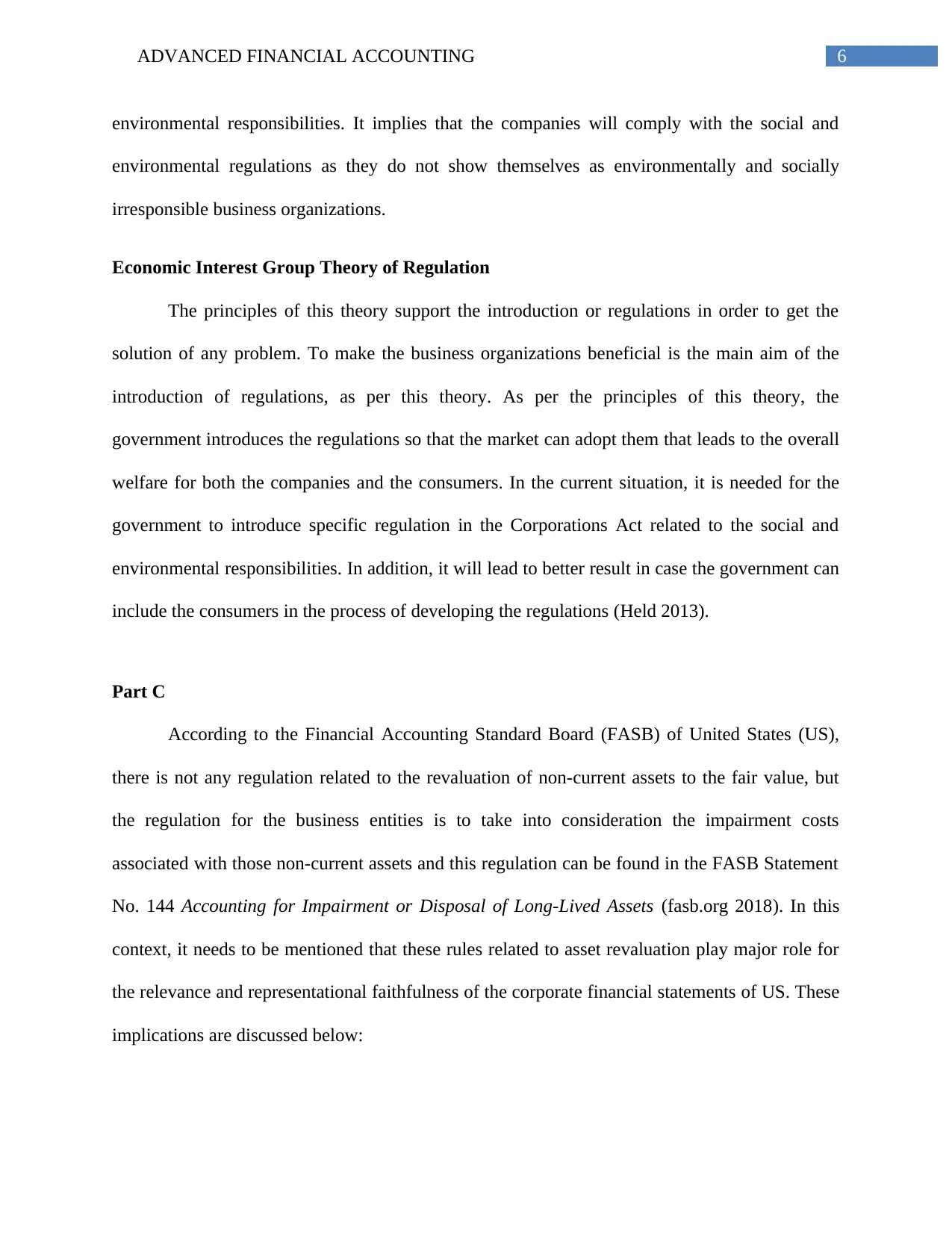
6ADVANCED FINANCIAL ACCOUNTING
environmental responsibilities. It implies that the companies will comply with the social and
environmental regulations as they do not show themselves as environmentally and socially
irresponsible business organizations.
Economic Interest Group Theory of Regulation
The principles of this theory support the introduction or regulations in order to get the
solution of any problem. To make the business organizations beneficial is the main aim of the
introduction of regulations, as per this theory. As per the principles of this theory, the
government introduces the regulations so that the market can adopt them that leads to the overall
welfare for both the companies and the consumers. In the current situation, it is needed for the
government to introduce specific regulation in the Corporations Act related to the social and
environmental responsibilities. In addition, it will lead to better result in case the government can
include the consumers in the process of developing the regulations (Held 2013).
Part C
According to the Financial Accounting Standard Board (FASB) of United States (US),
there is not any regulation related to the revaluation of non-current assets to the fair value, but
the regulation for the business entities is to take into consideration the impairment costs
associated with those non-current assets and this regulation can be found in the FASB Statement
No. 144 Accounting for Impairment or Disposal of Long-Lived Assets (fasb.org 2018). In this
context, it needs to be mentioned that these rules related to asset revaluation play major role for
the relevance and representational faithfulness of the corporate financial statements of US. These
implications are discussed below:
environmental responsibilities. It implies that the companies will comply with the social and
environmental regulations as they do not show themselves as environmentally and socially
irresponsible business organizations.
Economic Interest Group Theory of Regulation
The principles of this theory support the introduction or regulations in order to get the
solution of any problem. To make the business organizations beneficial is the main aim of the
introduction of regulations, as per this theory. As per the principles of this theory, the
government introduces the regulations so that the market can adopt them that leads to the overall
welfare for both the companies and the consumers. In the current situation, it is needed for the
government to introduce specific regulation in the Corporations Act related to the social and
environmental responsibilities. In addition, it will lead to better result in case the government can
include the consumers in the process of developing the regulations (Held 2013).
Part C
According to the Financial Accounting Standard Board (FASB) of United States (US),
there is not any regulation related to the revaluation of non-current assets to the fair value, but
the regulation for the business entities is to take into consideration the impairment costs
associated with those non-current assets and this regulation can be found in the FASB Statement
No. 144 Accounting for Impairment or Disposal of Long-Lived Assets (fasb.org 2018). In this
context, it needs to be mentioned that these rules related to asset revaluation play major role for
the relevance and representational faithfulness of the corporate financial statements of US. These
implications are discussed below:
Paraphrase This Document
Need a fresh take? Get an instant paraphrase of this document with our AI Paraphraser
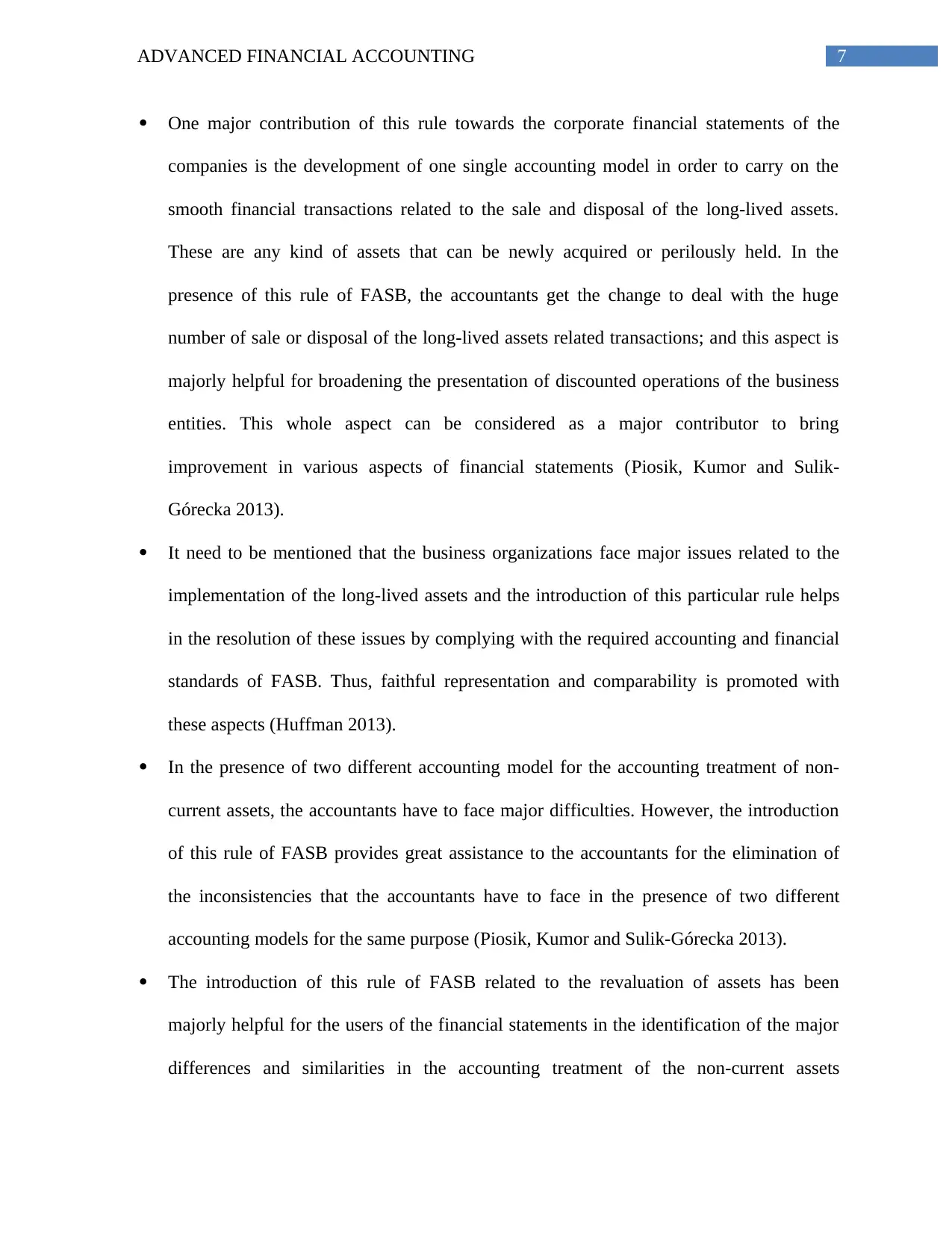
7ADVANCED FINANCIAL ACCOUNTING
One major contribution of this rule towards the corporate financial statements of the
companies is the development of one single accounting model in order to carry on the
smooth financial transactions related to the sale and disposal of the long-lived assets.
These are any kind of assets that can be newly acquired or perilously held. In the
presence of this rule of FASB, the accountants get the change to deal with the huge
number of sale or disposal of the long-lived assets related transactions; and this aspect is
majorly helpful for broadening the presentation of discounted operations of the business
entities. This whole aspect can be considered as a major contributor to bring
improvement in various aspects of financial statements (Piosik, Kumor and Sulik-
Górecka 2013).
It need to be mentioned that the business organizations face major issues related to the
implementation of the long-lived assets and the introduction of this particular rule helps
in the resolution of these issues by complying with the required accounting and financial
standards of FASB. Thus, faithful representation and comparability is promoted with
these aspects (Huffman 2013).
In the presence of two different accounting model for the accounting treatment of non-
current assets, the accountants have to face major difficulties. However, the introduction
of this rule of FASB provides great assistance to the accountants for the elimination of
the inconsistencies that the accountants have to face in the presence of two different
accounting models for the same purpose (Piosik, Kumor and Sulik-Górecka 2013).
The introduction of this rule of FASB related to the revaluation of assets has been
majorly helpful for the users of the financial statements in the identification of the major
differences and similarities in the accounting treatment of the non-current assets
One major contribution of this rule towards the corporate financial statements of the
companies is the development of one single accounting model in order to carry on the
smooth financial transactions related to the sale and disposal of the long-lived assets.
These are any kind of assets that can be newly acquired or perilously held. In the
presence of this rule of FASB, the accountants get the change to deal with the huge
number of sale or disposal of the long-lived assets related transactions; and this aspect is
majorly helpful for broadening the presentation of discounted operations of the business
entities. This whole aspect can be considered as a major contributor to bring
improvement in various aspects of financial statements (Piosik, Kumor and Sulik-
Górecka 2013).
It need to be mentioned that the business organizations face major issues related to the
implementation of the long-lived assets and the introduction of this particular rule helps
in the resolution of these issues by complying with the required accounting and financial
standards of FASB. Thus, faithful representation and comparability is promoted with
these aspects (Huffman 2013).
In the presence of two different accounting model for the accounting treatment of non-
current assets, the accountants have to face major difficulties. However, the introduction
of this rule of FASB provides great assistance to the accountants for the elimination of
the inconsistencies that the accountants have to face in the presence of two different
accounting models for the same purpose (Piosik, Kumor and Sulik-Górecka 2013).
The introduction of this rule of FASB related to the revaluation of assets has been
majorly helpful for the users of the financial statements in the identification of the major
differences and similarities in the accounting treatment of the non-current assets
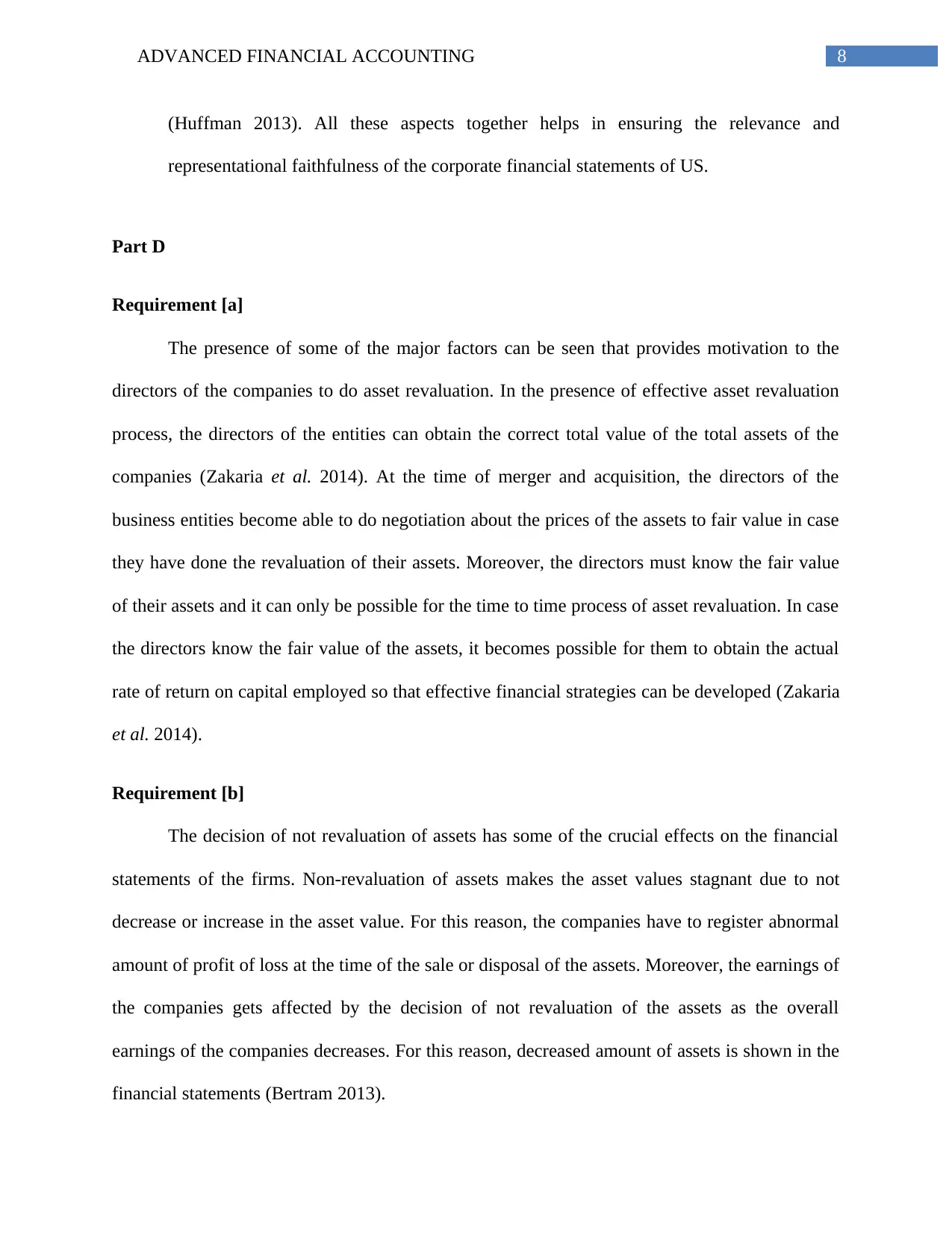
8ADVANCED FINANCIAL ACCOUNTING
(Huffman 2013). All these aspects together helps in ensuring the relevance and
representational faithfulness of the corporate financial statements of US.
Part D
Requirement [a]
The presence of some of the major factors can be seen that provides motivation to the
directors of the companies to do asset revaluation. In the presence of effective asset revaluation
process, the directors of the entities can obtain the correct total value of the total assets of the
companies (Zakaria et al. 2014). At the time of merger and acquisition, the directors of the
business entities become able to do negotiation about the prices of the assets to fair value in case
they have done the revaluation of their assets. Moreover, the directors must know the fair value
of their assets and it can only be possible for the time to time process of asset revaluation. In case
the directors know the fair value of the assets, it becomes possible for them to obtain the actual
rate of return on capital employed so that effective financial strategies can be developed (Zakaria
et al. 2014).
Requirement [b]
The decision of not revaluation of assets has some of the crucial effects on the financial
statements of the firms. Non-revaluation of assets makes the asset values stagnant due to not
decrease or increase in the asset value. For this reason, the companies have to register abnormal
amount of profit of loss at the time of the sale or disposal of the assets. Moreover, the earnings of
the companies gets affected by the decision of not revaluation of the assets as the overall
earnings of the companies decreases. For this reason, decreased amount of assets is shown in the
financial statements (Bertram 2013).
(Huffman 2013). All these aspects together helps in ensuring the relevance and
representational faithfulness of the corporate financial statements of US.
Part D
Requirement [a]
The presence of some of the major factors can be seen that provides motivation to the
directors of the companies to do asset revaluation. In the presence of effective asset revaluation
process, the directors of the entities can obtain the correct total value of the total assets of the
companies (Zakaria et al. 2014). At the time of merger and acquisition, the directors of the
business entities become able to do negotiation about the prices of the assets to fair value in case
they have done the revaluation of their assets. Moreover, the directors must know the fair value
of their assets and it can only be possible for the time to time process of asset revaluation. In case
the directors know the fair value of the assets, it becomes possible for them to obtain the actual
rate of return on capital employed so that effective financial strategies can be developed (Zakaria
et al. 2014).
Requirement [b]
The decision of not revaluation of assets has some of the crucial effects on the financial
statements of the firms. Non-revaluation of assets makes the asset values stagnant due to not
decrease or increase in the asset value. For this reason, the companies have to register abnormal
amount of profit of loss at the time of the sale or disposal of the assets. Moreover, the earnings of
the companies gets affected by the decision of not revaluation of the assets as the overall
earnings of the companies decreases. For this reason, decreased amount of assets is shown in the
financial statements (Bertram 2013).
⊘ This is a preview!⊘
Do you want full access?
Subscribe today to unlock all pages.

Trusted by 1+ million students worldwide
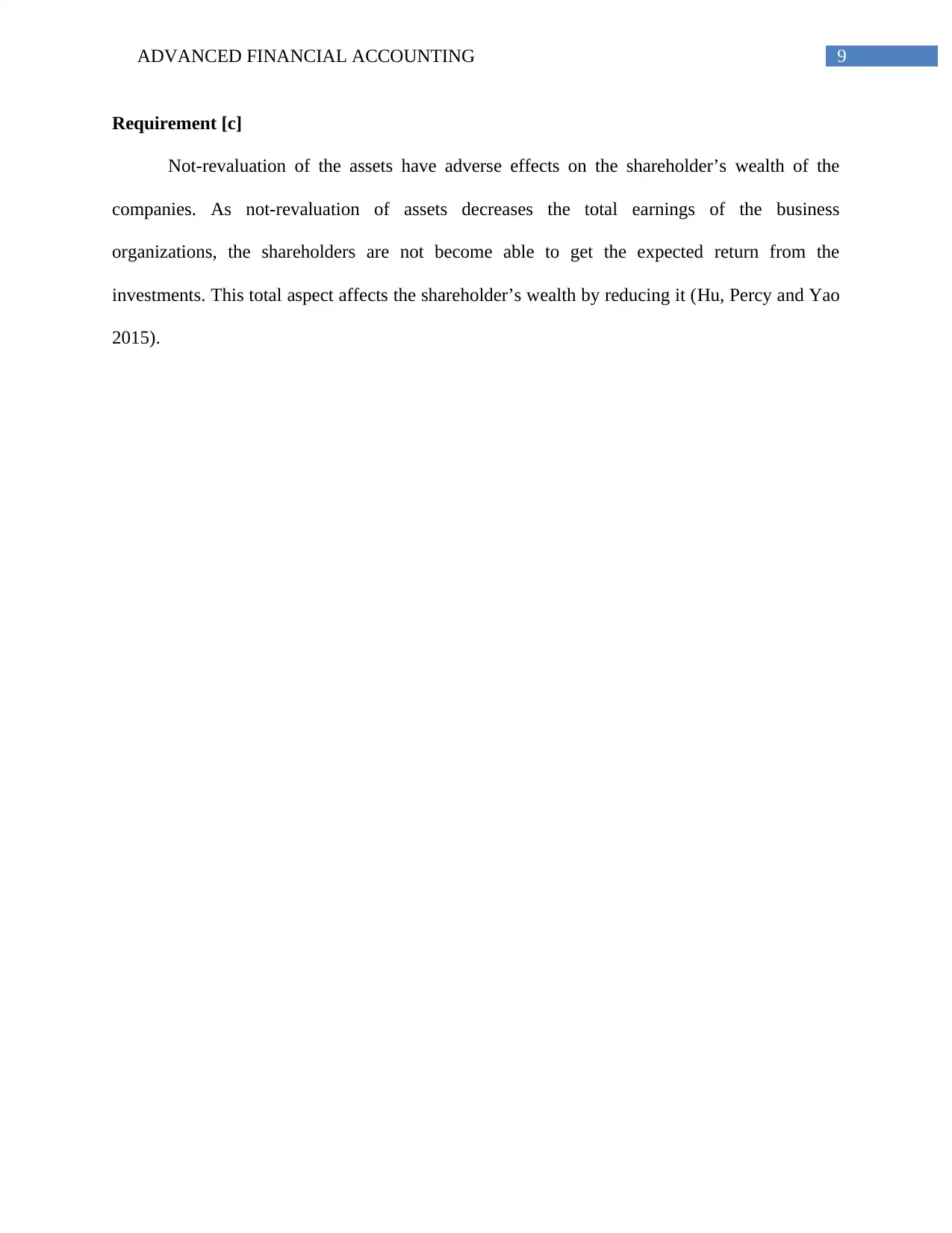
9ADVANCED FINANCIAL ACCOUNTING
Requirement [c]
Not-revaluation of the assets have adverse effects on the shareholder’s wealth of the
companies. As not-revaluation of assets decreases the total earnings of the business
organizations, the shareholders are not become able to get the expected return from the
investments. This total aspect affects the shareholder’s wealth by reducing it (Hu, Percy and Yao
2015).
Requirement [c]
Not-revaluation of the assets have adverse effects on the shareholder’s wealth of the
companies. As not-revaluation of assets decreases the total earnings of the business
organizations, the shareholders are not become able to get the expected return from the
investments. This total aspect affects the shareholder’s wealth by reducing it (Hu, Percy and Yao
2015).
Paraphrase This Document
Need a fresh take? Get an instant paraphrase of this document with our AI Paraphraser
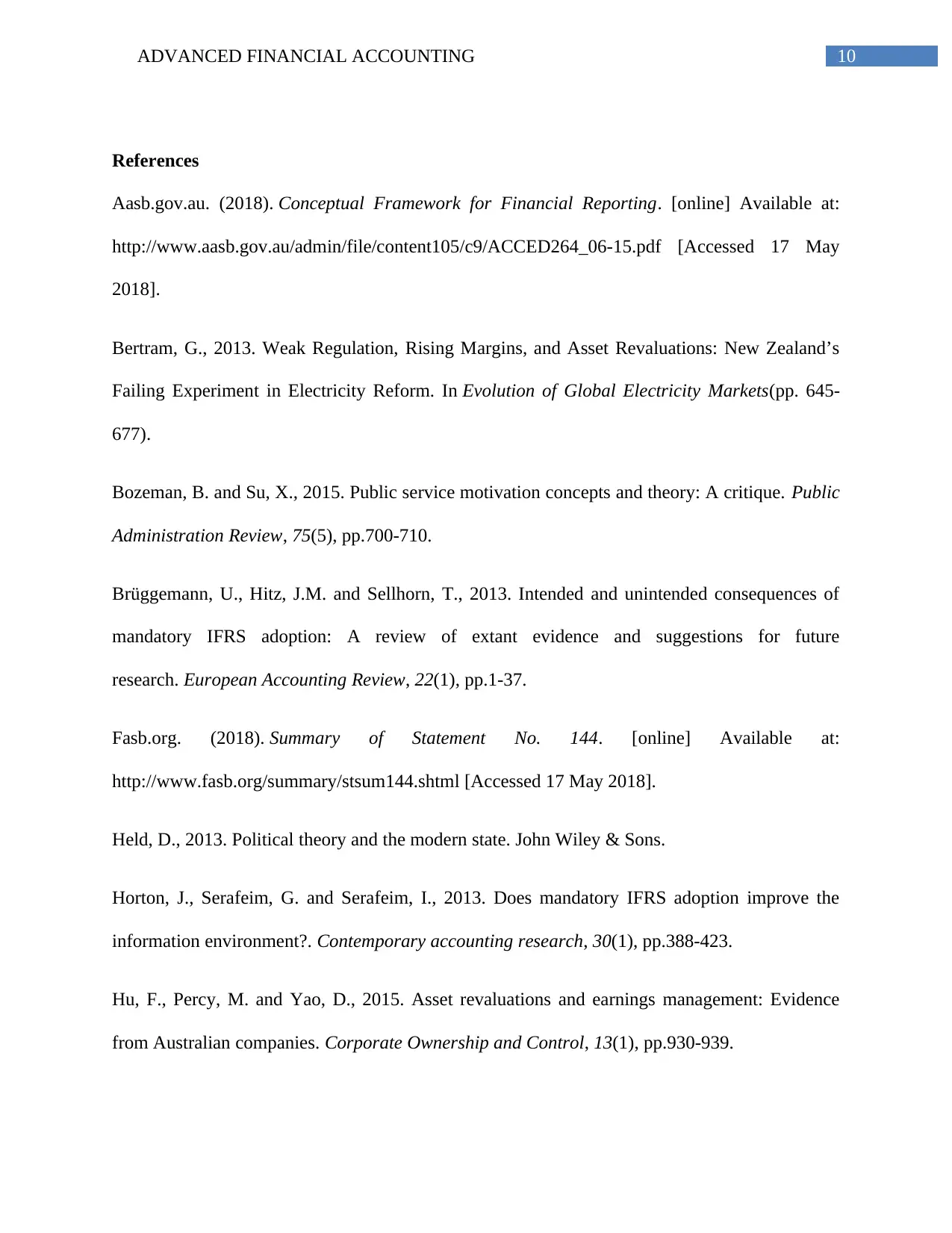
10ADVANCED FINANCIAL ACCOUNTING
References
Aasb.gov.au. (2018). Conceptual Framework for Financial Reporting. [online] Available at:
http://www.aasb.gov.au/admin/file/content105/c9/ACCED264_06-15.pdf [Accessed 17 May
2018].
Bertram, G., 2013. Weak Regulation, Rising Margins, and Asset Revaluations: New Zealand’s
Failing Experiment in Electricity Reform. In Evolution of Global Electricity Markets(pp. 645-
677).
Bozeman, B. and Su, X., 2015. Public service motivation concepts and theory: A critique. Public
Administration Review, 75(5), pp.700-710.
Brüggemann, U., Hitz, J.M. and Sellhorn, T., 2013. Intended and unintended consequences of
mandatory IFRS adoption: A review of extant evidence and suggestions for future
research. European Accounting Review, 22(1), pp.1-37.
Fasb.org. (2018). Summary of Statement No. 144. [online] Available at:
http://www.fasb.org/summary/stsum144.shtml [Accessed 17 May 2018].
Held, D., 2013. Political theory and the modern state. John Wiley & Sons.
Horton, J., Serafeim, G. and Serafeim, I., 2013. Does mandatory IFRS adoption improve the
information environment?. Contemporary accounting research, 30(1), pp.388-423.
Hu, F., Percy, M. and Yao, D., 2015. Asset revaluations and earnings management: Evidence
from Australian companies. Corporate Ownership and Control, 13(1), pp.930-939.
References
Aasb.gov.au. (2018). Conceptual Framework for Financial Reporting. [online] Available at:
http://www.aasb.gov.au/admin/file/content105/c9/ACCED264_06-15.pdf [Accessed 17 May
2018].
Bertram, G., 2013. Weak Regulation, Rising Margins, and Asset Revaluations: New Zealand’s
Failing Experiment in Electricity Reform. In Evolution of Global Electricity Markets(pp. 645-
677).
Bozeman, B. and Su, X., 2015. Public service motivation concepts and theory: A critique. Public
Administration Review, 75(5), pp.700-710.
Brüggemann, U., Hitz, J.M. and Sellhorn, T., 2013. Intended and unintended consequences of
mandatory IFRS adoption: A review of extant evidence and suggestions for future
research. European Accounting Review, 22(1), pp.1-37.
Fasb.org. (2018). Summary of Statement No. 144. [online] Available at:
http://www.fasb.org/summary/stsum144.shtml [Accessed 17 May 2018].
Held, D., 2013. Political theory and the modern state. John Wiley & Sons.
Horton, J., Serafeim, G. and Serafeim, I., 2013. Does mandatory IFRS adoption improve the
information environment?. Contemporary accounting research, 30(1), pp.388-423.
Hu, F., Percy, M. and Yao, D., 2015. Asset revaluations and earnings management: Evidence
from Australian companies. Corporate Ownership and Control, 13(1), pp.930-939.

11ADVANCED FINANCIAL ACCOUNTING
Huffman, A.A., 2013. Value relevant asset measurement and asset use: Evidence from IAS
41. USA: David Eccles School of Business, University of Utah.
Mitnick, B.M., 2015. Capturing" Capture": Developing a Normative Theory of Fiducial
Regulation.
Piosik, A.K., Kumor, I. and Sulik-Górecka, A., 2013. Associations between upward revaluation
of property, plant and equipment with information value of financial statements. Evidence from
Poland. Zeszyty Teoretyczne Rachunkowosci, 73(129).
Vohs, K.D. and Baumeister, R.F. eds., 2016. Handbook of self-regulation: Research, theory, and
applications. Guilford Publications.
Waldman, D. and Jensen, E., 2016. Industrial organization: theory and practice. Routledge.
Zakaria, A., Edwards, D., Holt, G.D. and Ramachandran, V., 2014. A Review of Property, Plant
and Equipment Asset Revaluation Decision Making in Indonesia: Development of a Conceptual
Model. Mindanao Journal of Science and Technology, 12(2014), pp.109-128.
Huffman, A.A., 2013. Value relevant asset measurement and asset use: Evidence from IAS
41. USA: David Eccles School of Business, University of Utah.
Mitnick, B.M., 2015. Capturing" Capture": Developing a Normative Theory of Fiducial
Regulation.
Piosik, A.K., Kumor, I. and Sulik-Górecka, A., 2013. Associations between upward revaluation
of property, plant and equipment with information value of financial statements. Evidence from
Poland. Zeszyty Teoretyczne Rachunkowosci, 73(129).
Vohs, K.D. and Baumeister, R.F. eds., 2016. Handbook of self-regulation: Research, theory, and
applications. Guilford Publications.
Waldman, D. and Jensen, E., 2016. Industrial organization: theory and practice. Routledge.
Zakaria, A., Edwards, D., Holt, G.D. and Ramachandran, V., 2014. A Review of Property, Plant
and Equipment Asset Revaluation Decision Making in Indonesia: Development of a Conceptual
Model. Mindanao Journal of Science and Technology, 12(2014), pp.109-128.
⊘ This is a preview!⊘
Do you want full access?
Subscribe today to unlock all pages.

Trusted by 1+ million students worldwide
1 out of 12
Related Documents
Your All-in-One AI-Powered Toolkit for Academic Success.
+13062052269
info@desklib.com
Available 24*7 on WhatsApp / Email
![[object Object]](/_next/static/media/star-bottom.7253800d.svg)
Unlock your academic potential
Copyright © 2020–2026 A2Z Services. All Rights Reserved. Developed and managed by ZUCOL.





